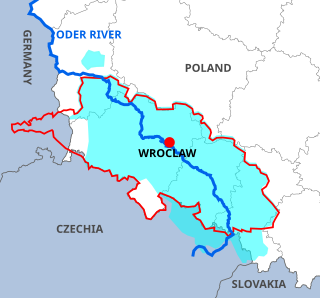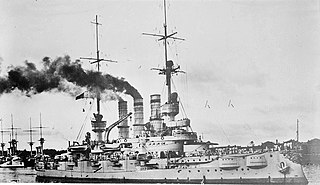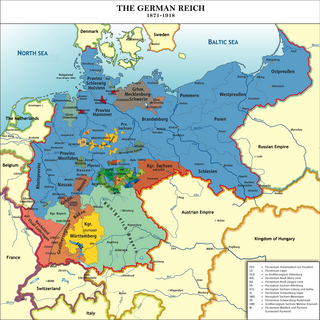
Silesia is a historical region of Central Europe that lies mostly within Poland, with small parts in the Czech Republic and Germany. Its area is approximately 40,000 km2 (15,400 sq mi), and the population is estimated at around 8,000,000. Silesia is split into two main subregions, Lower Silesia in the west and Upper Silesia in the east. Silesia has a diverse culture, including architecture, costumes, cuisine, traditions, and the Silesian language.
Silesian, Silesian German or Lower Silesian is a nearly extinct German dialect spoken in Silesia. It is part of the East Central German language area with some West Slavic and Lechitic influences. Silesian German emerged as the result of Late Medieval German migration to Silesia, which had been inhabited by Lechitic or West Slavic peoples in the Early Middle Ages.

The Province of Silesia was a province of Prussia from 1815 to 1919. The Silesia region was part of the Prussian realm since 1740 and established as an official province in 1815, then became part of the German Empire in 1871. In 1919, as part of the Free State of Prussia within Weimar Germany, Silesia was divided into the provinces of Upper Silesia and Lower Silesia. Silesia was reunified briefly from 1 April 1938 to 27 January 1941 as a province of Nazi Germany before being divided back into Upper Silesia and Lower Silesia.
The Landsmannschaft Schlesien - Nieder- und Oberschlesien e.V. is an organization of Germans born in the former Prussian provinces of Lower and Upper Silesia, and their descendants, who currently live in Germany. The Landsmannschaft Schlesien was established in March 1950 and is a member of the Federation of Expellees, and has its headquarters in Königswinter, North Rhine-Westphalia.

Herbert Hupka was a German journalist, politician, and advocate for the Germans expelled from neighbouring countries after the Second World War.
Neumarkt may refer to several places:

New Silesia was a small province of the Kingdom of Prussia from 1795 to 1807, created after the Third Partition of Poland. It was located northwest of Kraków and southeast of Częstochowa, in the lands that had been part of the Duchy of Siewierz and the adjacent Polish historical province of Lesser Poland, including the towns of Żarki, Pilica, Będzin, and Sławków.

The Province of Upper Silesia was a province of the Free State of Prussia from 1919 to 1945. It comprised much of the region of Upper Silesia and was eventually divided into two government regions (Regierungsbezirke) called Kattowitz (1939–1945), and Oppeln (1819–1945). The provincial capital was Oppeln (1919–1938) and Kattowitz (1941–1945), while other major towns included Beuthen, Gleiwitz, Hindenburg O.S., Neiße, Ratibor and Auschwitz, added in 1941. Between 1938 and 1941 it was reunited with Lower Silesia as the Province of Silesia.

SMS Schlesien was one of five Deutschland-class pre-dreadnought battleships built for the German Kaiserliche Marine between 1904 and 1906. Named after the German province of Silesia, Schlesien was laid down at the Schichau-Werke shipyard in Danzig on 19 November 1904, launched on 28 May 1906, and commissioned on 5 May 1908. She was armed with a battery of four 28 cm (11 in) guns and had a top speed of 18 knots. The ships of her class were already outdated by the time they entered service, as they were inferior in size, armor, firepower, and speed to the revolutionary new British battleship HMS Dreadnought.

Austrian Silesia, officially the Duchy of Upper and Lower Silesia, was an autonomous region of the Kingdom of Bohemia and the Habsburg monarchy. It is largely coterminous with the present-day region of Czech Silesia and was, historically, part of the larger Silesia region.
Silesia is a historical region in Central Europe.

The Gauliga Schlesien was the highest football league in the region of Silesia (German:Schlesien), which consisted of the Prussian provinces of Lower Silesia and Upper Silesia from 1933 to 1945. Shortly after the formation of the league, the Nazis reorganised the administrative regions in Germany, and the Gau Silesia, later subdivided into Gau Upper Silesia and Gau Lower Silesia, replaced the Prussian provinces.
East Upper Silesia is the easternmost extremity of Silesia, the eastern part of the Upper Silesian region around the city of Katowice. The term is used primarily to denote those areas that became part of the Second Polish Republic on 20 June 1922, as a consequence of the post-World War I Treaty of Versailles. Prior to World War II, the Second Polish Republic administered the area as Autonomous Silesian Voivodeship. East Upper Silesia was also known as Polish (Upper) Silesia, and the German (Upper) Silesia was known as West Upper Silesia.
Ewald Stefan Pollok publicist, author of several books on the subject of Silesia.

Duchy of Jawor was one of the Duchies of Silesia established in 1274 as a subdivision of the Duchy of Legnica. It was ruled by the Silesian Piasts, with its capital at Jawor in Lower Silesia.

The South Eastern German football championship was the highest association football competition in the Prussian provinces of Silesia, which was divided into the Province of Lower Silesia and the Province of Upper Silesia after 1919, and Posen, which mostly became part of Poland in 1919. The competition was disbanded in 1933.
Schlesische Arbeiter-Zeitung was a left-wing German language newspaper published from Breslau, Province of Lower Silesia, Weimar Germany between 1919 and 1933.

The Gau Silesia formed on 15 March 1925, was an administrative division of Nazi Germany from 1933 to 1941 in the Prussian Province of Silesia. From 1925 to 1933, it was the regional subdivision of the Nazi Party for this area. The Gau was split into Lower Silesia and Upper Silesia on 27 January 1941. The majority of the former Gau became part of Poland after the Second World War, with small parts in the far west becoming part of the future East Germany.
Shlesinger is a surname derived from Schlesien, the German name for Silesia.
Several steamships have been named Silesia after the province of Schlesien










